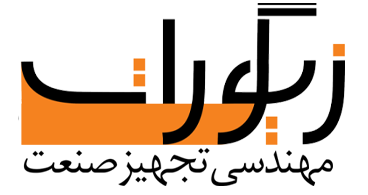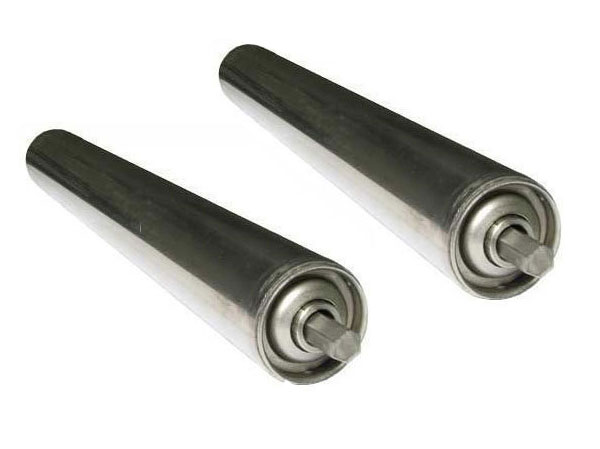Introduction and Application of Pressed Rollers
Pressed rollers, also known as conventional rollers, are one of the oldest and most common types of rollers used in conveyor belts. They are categorized based on material (steel, iron, and galvanized), dimensions, application, and age. This type of roller is more affordable than other types because it uses old bearings. Like other rollers, it rotates the conveyor belt and creates friction between the conveyed material and the belt surface.
Pressed rollers require constant attention and monitoring because they are constantly subjected to wear. This model of roller has a wide range of applications in various industries, and its advantages include ease of use and low cost. In this article, we will discuss the applications of pressed rollers and their characteristics.
Components of Pressed Rollers
Although this product is a simple and conventional roller, it is one of the critical components in conveyors and has extensive applications in various industries. All the main components of this type of roller are placed inside a cylindrical housing in a pressed form, and there is no possibility of changing or opening it. If a small part inside the roller breaks down, it cannot be replaced, which can render the roller useless. However, this has not stopped its purchase and use; it is popular due to its ease of use. The low price of this type of roller compared to other rollers has also increased its purchase. The following are some of the components used in the manufacturing of this product:
- Two bearings: To increase sales and quality, it is recommended to use anti-rust and waterproof bearings.
- A steel rod: A steel rod is used to increase strength and durability.
- High-quality materials: Using high-quality and pure materials in the manufacturing process can improve the roller’s quality.
- Two flat washers
- A housing for placement
- A die
- Two perforated caps for closing
Applications of Pressed Rollers
The following are some of the applications of pressed rollers:
- Technical and industrial complexes
- Shopping centers
- Airports
- Industrial equipment stores
- Sand and gravel washing plants
- Conveyors
- Feeding machines
- Paper mills
- Stamping machines
- Bending machines
- Textile industries
- Printing houses
- Packaging industries
- Transportation of minerals in mines
- Stamping machines
- Bending machines
- Textile industries
- Printing houses
Pressed rollers with diameters of six to 16 centimeters are used in heavy-duty applications, while lightweight rollers with diameters of two to six centimeters are used in light-duty applications. Plain rollers are the most common, inexpensive, and simplest type of roller.
Manufacturing Process of Pressed Rollers
The following steps are involved in the manufacturing process of pressed rollers:
- The pipe is cut using a cutting saw.
- The cutting waste is placed in a lathe machine.
- The roller is gently placed into the template mold using a hammer.
- The necessary connections are made using a CO2 welding machine.
- The shaft is manually turned.
- The workpiece is slotted using a lathe machine.
- The bearings are placed inside according to the خارها.
- The roller is pressed and sealed.
- The product is tested by experts (if approved, the product is painted and packaged).
- The product is offered for sale.
Where are Pressed Rollers Located?
One of the most widely used types of rollers is the pressed or conventional roller, which is primarily used in conveyor belt systems to move the belt. The lifespan of the conveyor belt depends on the lifespan of the pressed roller. The idler system is the system in which the pressed roller is placed and performs its function. This type of roller is known by various names, the most popular of which is drum. This type of roller is more affordable than other rollers and is available in various diameters and sizes. Its components include:
- Roller shaft
- Roller seal
- Roller bearing
In this model of roller, the rollers are pressed together, making it difficult to repair or replace them individually. All industrial machines and systems that require movement and material handling use pressed rollers.
Features and Specifications of a Pressed Roller
Pressed rollers are available in various diameters and types. This is why they are used in various industries. This type of roller is considered the simplest roller. The components of this type of roller are pressed together one by one. The use of old bearings in this type of roller has made it affordable.
One type of conventional or pressed roller is a 30 cm long and 7 cm diameter roller used on conveyor belts that need to carry more weight.
Similar to conveyor belts for transporting heavier bags, asphalt plant conveyor belts, and sand washing conveyor belts, this type of conventional roller has high resistance and the material of the pipe used for its production is st37.
Since this type of roller is pressed, it cannot be repaired if damaged or broken, and the entire roller must be replaced.
The technical specifications of a 7 cm diameter and 30 cm long pressed roller include:
- It is manufactured with Chinese ZZ bearings.
- It has a two-millimeter seamless steel pipe body with a double-threaded shaft.
- The threads are produced in a screw or slotted form.
- The caps are welded onto the pipe.
- The roller pipe has a two-millimeter thickness.
- The pipe material is galvanized, steel, or iron.
- The pipe diameter is 7 centimeters.
- The pipe length is 30 centimeters.
- The roller caps are made of iron or Teflon.
- There are two bearings on each side of the pipe.
- The shaft length is 8 centimeters from each side of the pipe.
Structure of Pressed Roller and Sealing Arrangement of Pressed Roller
On both sides of the sealing system, the pressed roller simultaneously acts as a dust and lubricant protector and has several sealing elements that prevent contaminants from entering the bearing. The interlocking edges are intertwined with the individual components of the circular shape, forming a labyrinth. The shape of the edges is designed to prevent the ingress of contaminants into the pressed roller housing without increasing the rotational friction resistance.
This system consists of two parts:
- A two-groove female labyrinth element
- A male labyrinth element
The space between the labyrinth edges is filled with NLGI grade two or three lithium grease to prevent fine dust particles.
Polypropylene-based and polyamide-based materials are considered sealing system elements.
The conventional or pressed roller is secured in position using a hardened steel spring ring according to DIN 471 to prevent axial movement of the conventional (pressed) roller shaft, which is placed directly on the grooved spindle.
For added protection of the pressed roller assembly, there is a metal end cap with a mold along with a compressed polyamide seal.
The final assembly is painted with 650 post red, synthetic enamel paint, two coats of red oxy paint, and 75 um of paint.
Applications of Pressed Roller in Various Industries
The conventional pressed roller has extensive applications in the industry and is considered the best roller for conveyor belt manufacturing.
This type of roller has two-millimeter pipes and bearings on both ends that give it an idler property.
There are caps on both ends of the pipes of this type of roller.
That’s why it’s called a pressed roller.
This type of roller is used in various industries, including:
- Packaging and recycling industries
- Warehouses
- Fertilizers
- Construction
- Asphalt and bulk
- Batching
- Steel
- Mining
- Cement
This type of roller is used in sand and gravel plants.
It is also used in industrial complexes of shopping centers.
This type of roller is used in industrial equipment stores in airports.
This type of roller allows the conveyor belt to move so that it can be used for transportation.
These types of rollers are constantly in friction and rotation.
Therefore, much attention should be paid to it.
The material of this type of roller is iron or galvanized.
Advantages of Pressed Roller
Some of the advantages of conventional or pressed rollers include:
- Saving time and money
Using a conventional or pressed roller saves time and money because it automatically performs the pressing operation.
- Separation of moving parts
Rollers are used as a separator between two moving parts, which allows them to approach each other without damaging or wearing the moving parts.
- High accuracy
It performs the pressing accurately and without errors, due to the system in place, which ensures that the final product is manufactured with high quality and accuracy.
- High speed
Using this type of roller allows the operation to be performed at a high speed.
The pressing of the parts is done at a high speed, and the production time is reduced.
- Easy to use
It is designed for easy use and reliability and automatically performs the pressing operation.
There is no need to manually manipulate the part.
- Versatile

